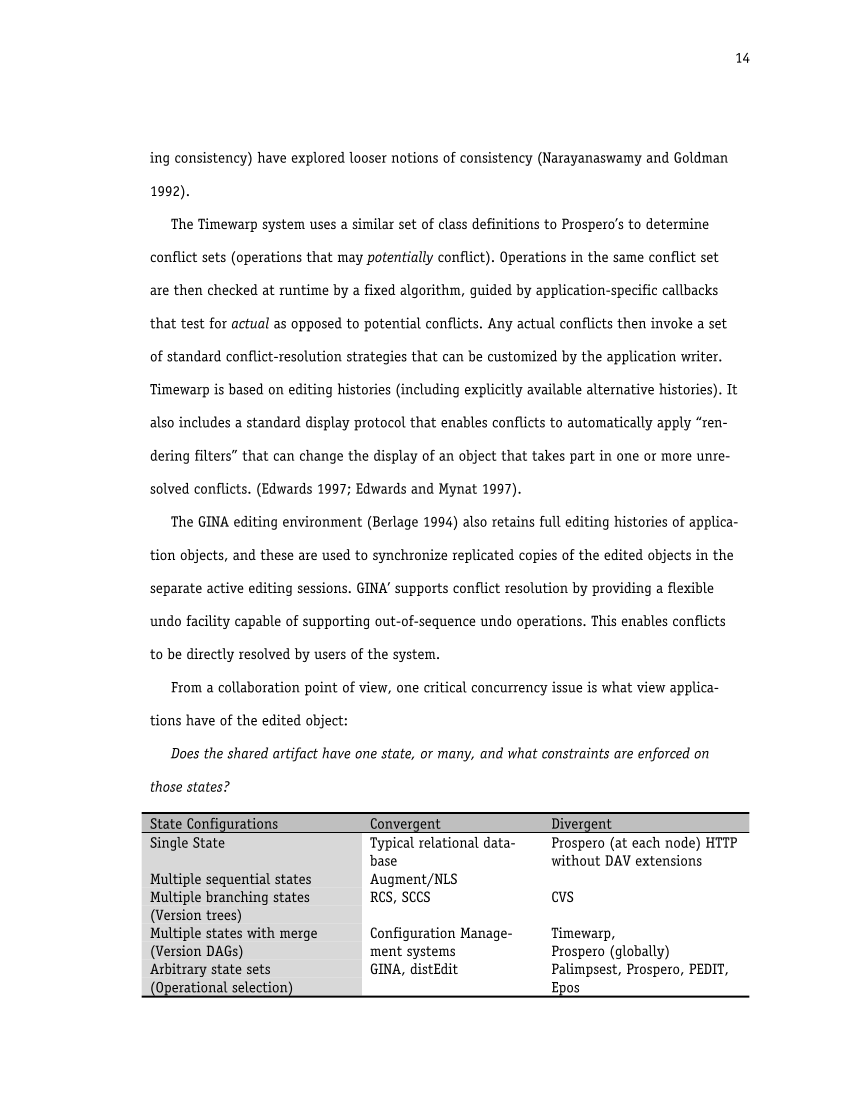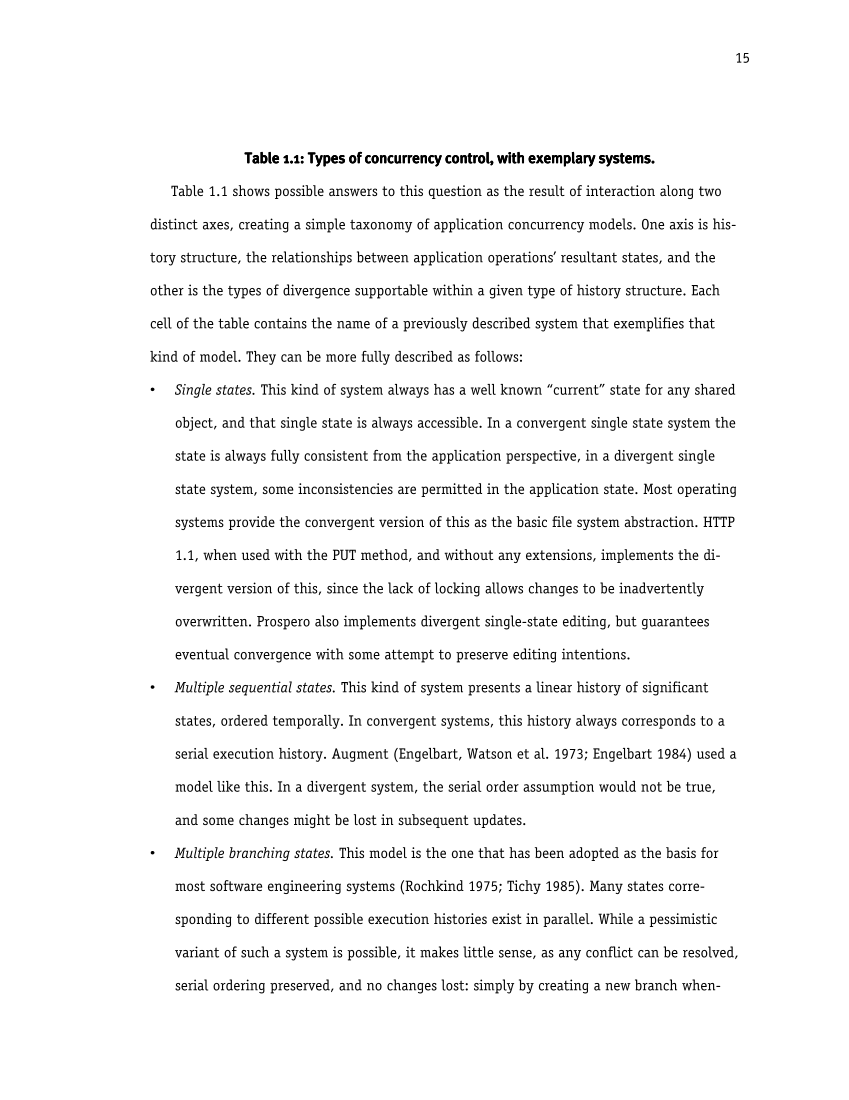14
ing�consistency)�have�explored�looser�notions�of�consistency�(Narayanaswamy�and�Goldman
1992).
The�Timewarp�system�uses�a�similar�set�of�class�definitions�to�Prospero’s�to�determine
conflict�sets�(operations�that�may�potentiallyconflict).�Operations�in�the�same�conflict�set
are�then�checked�at�runtime�by�a�fixed�algorithm,�guided�by�application-specific�callbacks
that�test�for�actualas�opposed�to�potential�conflicts.�Any�actual�conflicts�then�invoke�a�set
of�standard�conflict-resolution�strategies�that�can�be�customized�by�the�application�writer.
Timewarp�is�based�on�editing�histories�(including�explicitly�available�alternative�histories).�It
also�includes�a�standard�display�protocol�that�enables�conflicts�to�automatically�apply�“ren-
dering�filters”�that�can�change�the�display�of�an�object�that�takes�part�in�one�or�more�unre-
solved�conflicts.�(Edwards�1997;�Edwards�and�Mynat�1997).
The�GINA�editing�environment�(Berlage�1994)�also�retains�full�editing�histories�of�applica-
tion�objects,�and�these�are�used�to�synchronize�replicated�copies�of�the�edited�objects�in�the
separate�active�editing�sessions.�GINA’�supports�conflict�resolution�by�providing�a�flexible
undo�facility�capable�of�supporting�out-of-sequence�undo�operations.�This�enables�conflicts
to�be�directly�resolved�by�users�of�the�system.
From�a�collaboration�point�of�view,�one�critical�concurrency�issue�is�what�view�applica-
tions�have�of�the�edited�object:
Does�the�shared�artifact�have�one�state,�or�many,�and�what�constraints�are�enforced�on
those�states?
State�Configurations Convergent Divergent
Single�State Typical�relational�data-
base
Prospero�(at�each�node)�HTTP
without�DAV�extensions
Multiple�sequential�states Augment/NLS
Multiple�branching�states
(Version�trees)
RCS,�SCCS CVS
Multiple�states�with�merge
(Version�DAGs)
Configuration�Manage-
ment�systems
Timewarp,
Prospero�(globally)
Arbitrary�state�sets
(Operational�selection)
GINA,�distEdit Palimpsest,�Prospero,�PEDIT,
Epos
ing�consistency)�have�explored�looser�notions�of�consistency�(Narayanaswamy�and�Goldman
1992).
The�Timewarp�system�uses�a�similar�set�of�class�definitions�to�Prospero’s�to�determine
conflict�sets�(operations�that�may�potentiallyconflict).�Operations�in�the�same�conflict�set
are�then�checked�at�runtime�by�a�fixed�algorithm,�guided�by�application-specific�callbacks
that�test�for�actualas�opposed�to�potential�conflicts.�Any�actual�conflicts�then�invoke�a�set
of�standard�conflict-resolution�strategies�that�can�be�customized�by�the�application�writer.
Timewarp�is�based�on�editing�histories�(including�explicitly�available�alternative�histories).�It
also�includes�a�standard�display�protocol�that�enables�conflicts�to�automatically�apply�“ren-
dering�filters”�that�can�change�the�display�of�an�object�that�takes�part�in�one�or�more�unre-
solved�conflicts.�(Edwards�1997;�Edwards�and�Mynat�1997).
The�GINA�editing�environment�(Berlage�1994)�also�retains�full�editing�histories�of�applica-
tion�objects,�and�these�are�used�to�synchronize�replicated�copies�of�the�edited�objects�in�the
separate�active�editing�sessions.�GINA’�supports�conflict�resolution�by�providing�a�flexible
undo�facility�capable�of�supporting�out-of-sequence�undo�operations.�This�enables�conflicts
to�be�directly�resolved�by�users�of�the�system.
From�a�collaboration�point�of�view,�one�critical�concurrency�issue�is�what�view�applica-
tions�have�of�the�edited�object:
Does�the�shared�artifact�have�one�state,�or�many,�and�what�constraints�are�enforced�on
those�states?
State�Configurations Convergent Divergent
Single�State Typical�relational�data-
base
Prospero�(at�each�node)�HTTP
without�DAV�extensions
Multiple�sequential�states Augment/NLS
Multiple�branching�states
(Version�trees)
RCS,�SCCS CVS
Multiple�states�with�merge
(Version�DAGs)
Configuration�Manage-
ment�systems
Timewarp,
Prospero�(globally)
Arbitrary�state�sets
(Operational�selection)
GINA,�distEdit Palimpsest,�Prospero,�PEDIT,
Epos





























































































































































































